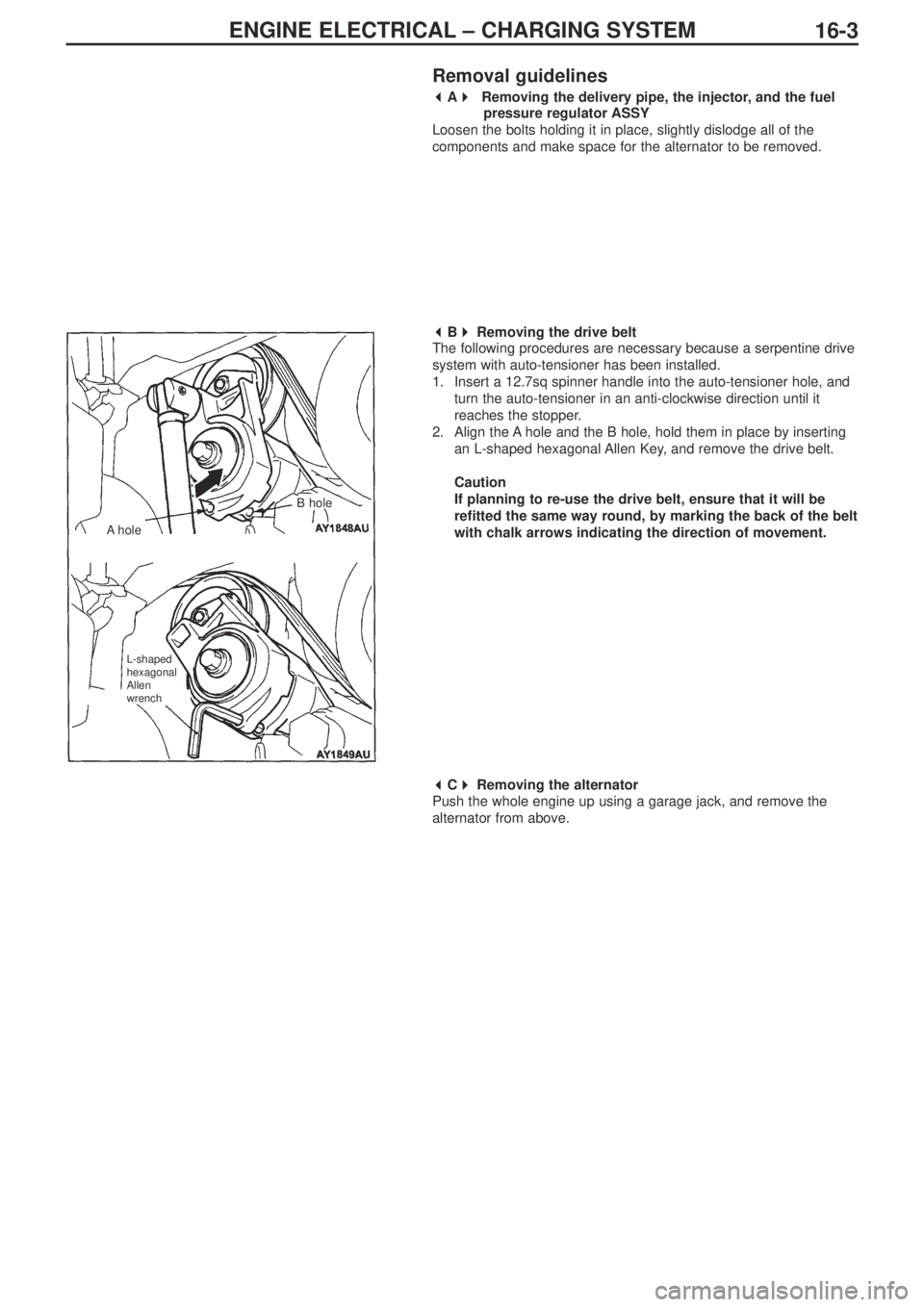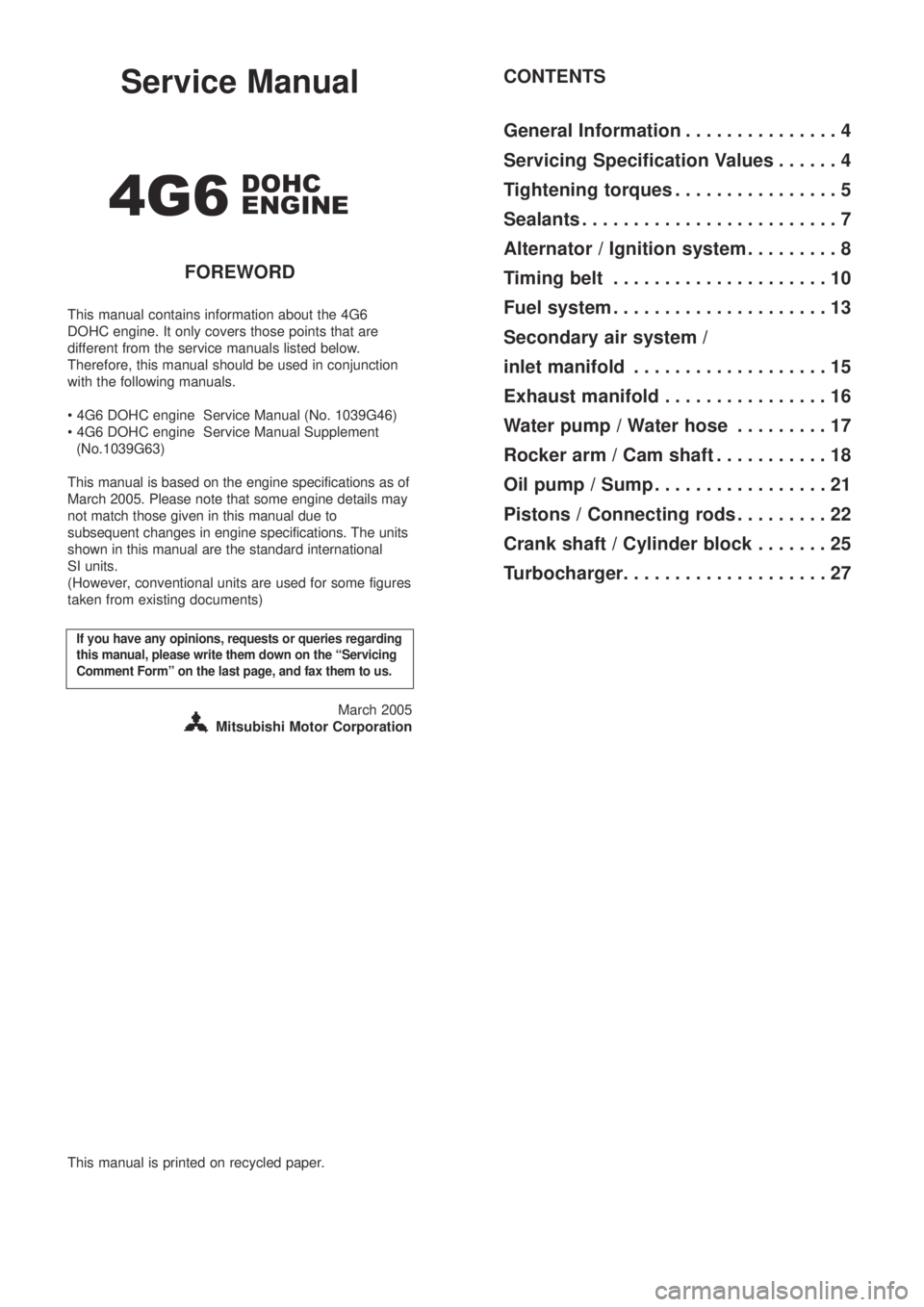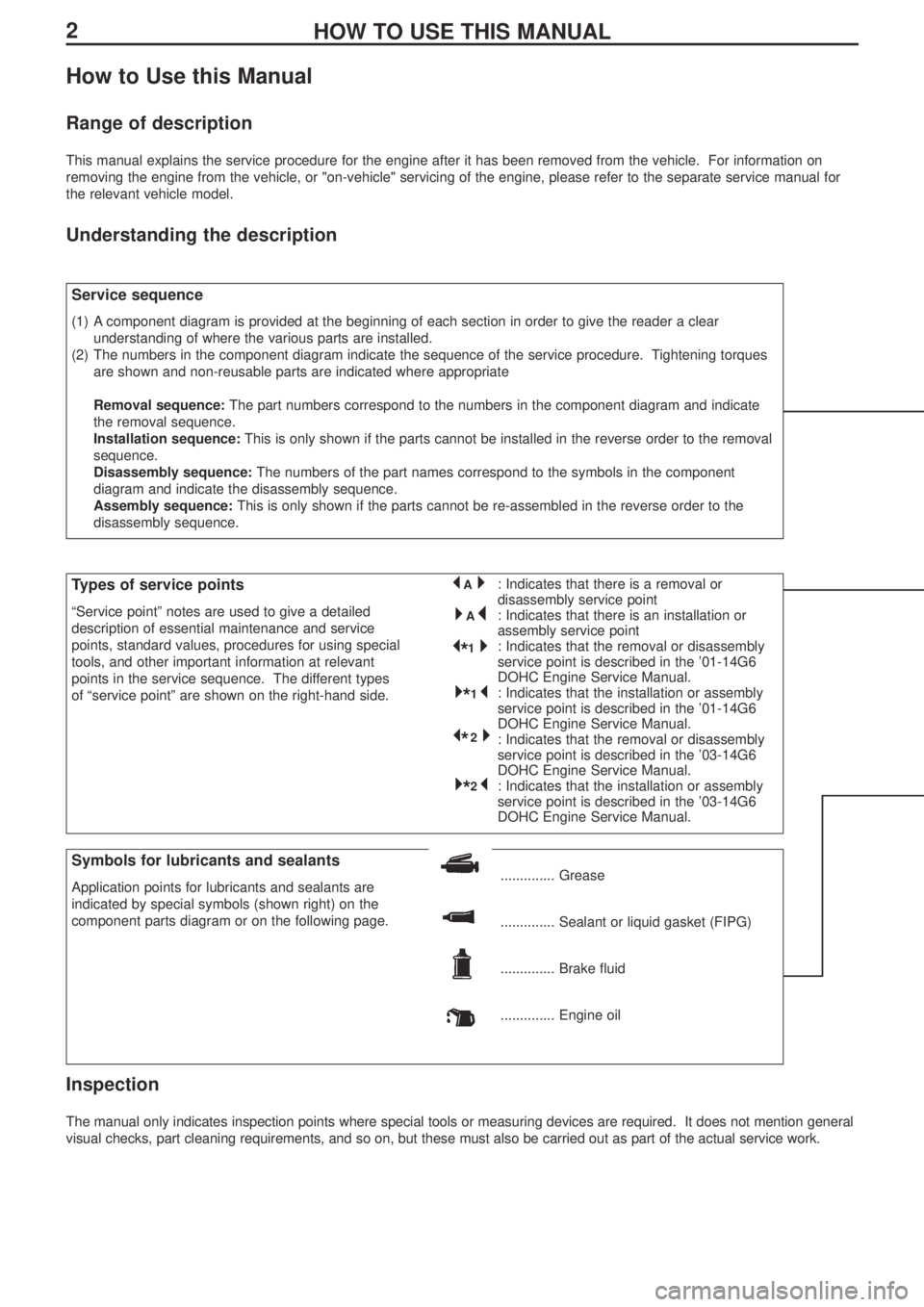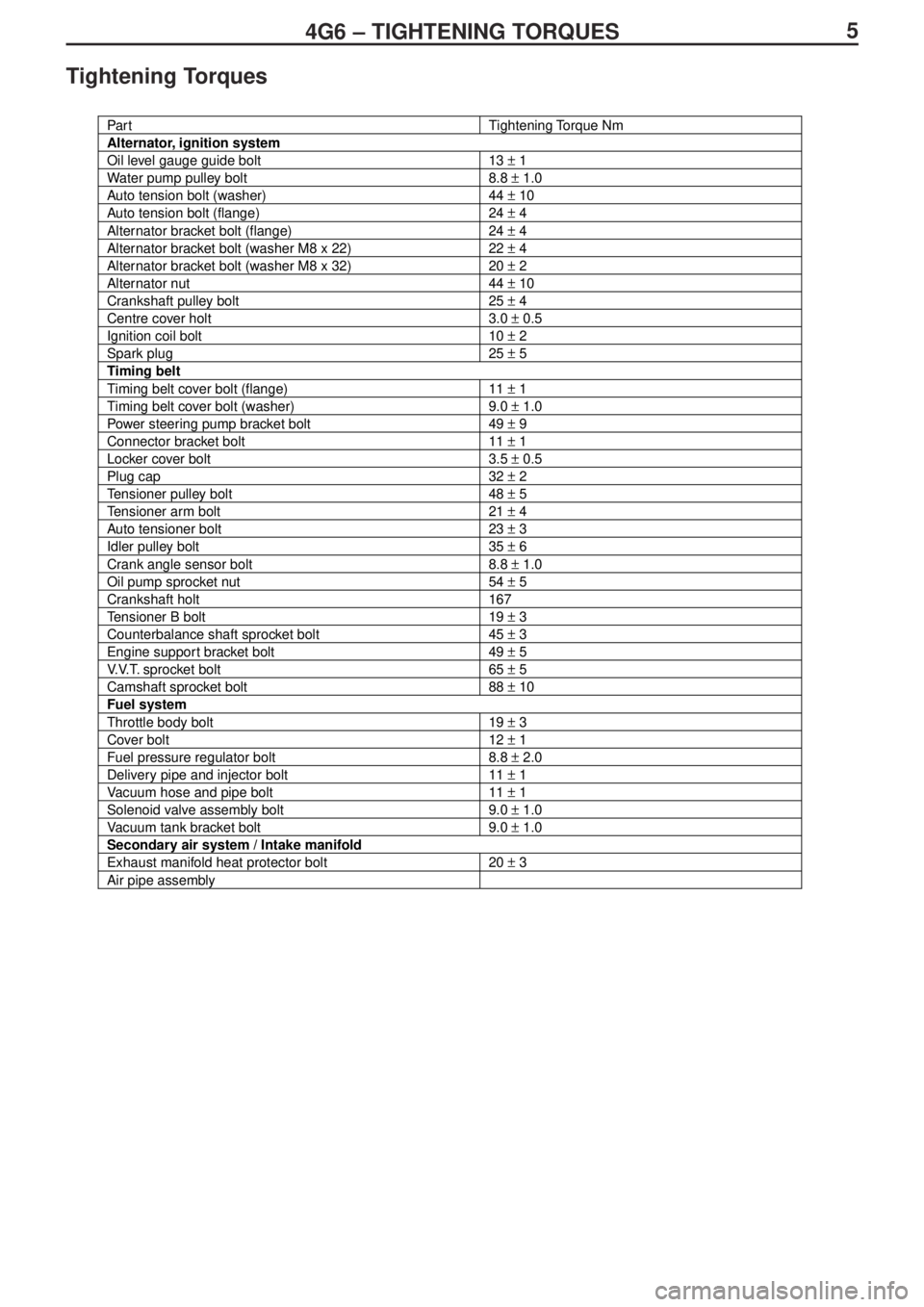Page 86 of 364
ENGINE ELECTRICAL – CHARGING SYSTEM16-2
Removal procedure
1. Injector connector
2. Accelerator cable connection
3. Delivery pipe, injector, and fuel pressure
regulator ASSY
4. Insulator
5. Insulator
6. Fuel pressure solenoid valve connector
7. Fuel pressure solenoid valve ASSY
8. Knock sensor connector
9. Purge control solenoid valve connector10. Purge control solenoid valve ASSY
11.Oil level gauge and guide ASSY
12. O-ring
13. Drive belt
14. Alternator connector and terminal
• Engine mount
15. Alternator
16. Water pump pulley
17. O
2sensor connector
18. Alternator bracket
(engine oil)
� �
A� ��
�
B� �
� �
C� �
Page 87 of 364

ENGINE ELECTRICAL – CHARGING SYSTEM
16-3
Removal guidelines
� �
A� �
Removing the delivery pipe, the injector, and the fuel
pressure regulator ASSY
Loosen the bolts holding it in place, slightly dislodge all of the
components and make space for the alternator to be removed.
� �
B� �
Removing the drive belt
The following procedures are necessary because a serpentine drive
system with auto-tensioner has been installed.
1. Insert a 12.7sq spinner handle into the auto-tensioner hole, and
turn the auto-tensioner in an anti-clockwise direction until it
reaches the stopper.
2. Align the A hole and the B hole, hold them in place by inserting
an L-shaped hexagonal Allen Key, and remove the drive belt.
Caution
If planning to re-use the drive belt, ensure that it will be
refitted the same way round, by marking the back of the belt
with chalk arrows indicating the direction of movement.
� �
C� �
Removing the alternator
Push the whole engine up using a garage jack, and remove the
alternator from above.
AholeB hole
L-shaped
hexagonal
Allen
wrench
Page 88 of 364
ENGINE ELECTRICAL – IGNITION SYSTEM16-4
Ignition system
General
The following servicing guidelines for spark plugs and the cam position sensor have been prepared for vehicles which use the
4G63-MIVEC-T/C engine. Other servicing guidelines remain unchanged.
Servicing standards
On-vehicle servicing
Checking cleaning and replacing spark plugs
The standard value and the upper limit for plug caps, has been changed in conjunction with the changes made to the spark
plugs. Other servicing guidelines remain unchanged.
Standard values and upper limits
Cam position sensor
Removal and fitting
Removal procedure
1. Cam position sensor connector
2. Cam position sensor
3. O-ringRemoval procedure
4. Cam position sensor connector
5. Cam position sensor
6. O-ring
ItemStandard ValueUpper Limit
Spark plug cap mm0.5~0.60.75
ManufacturerModelStandard Value mmUpper Limit mm
NGKILFR7H0.5~0.60.75
Page 108 of 364

Service Manual
4G6
FOREWORD
This manual contains information about the 4G6
DOHC engine. It only covers those points that are
different from the service manuals listed below.
Therefore, this manual should be used in conjunction
with the following manuals.
• 4G6 DOHC engine Service Manual (No. 1039G46)
• 4G6 DOHC engine Service Manual Supplement
(No.1039G63)
This manual is based on the engine specifications as of
March 2005. Please note that some engine details may
not match those given in this manual due to
subsequent changes in engine specifications. The units
shown in this manual are the standard international
SI units.
(However, conventional units are used for some figures
taken from existing documents)
If you have any opinions, requests or queries regarding
this manual, please write them down on the “Servicing
Comment Form” on the last page, and fax them to us.
March 2005
Mitsubishi Motor Corporation
This manual is printed on recycled paper.
CONTENTS
General Information . . . . . . . . . . . . . . . 4
Servicing Specification Values . . . . . . 4
Tightening torques . . . . . . . . . . . . . . . . 5
Sealants . . . . . . . . . . . . . . . . . . . . . . . . . 7
Alternator / Ignition system . . . . . . . . . 8
Timing belt . . . . . . . . . . . . . . . . . . . . . 10
Fuel system . . . . . . . . . . . . . . . . . . . . . 13
Secondary air system /
inlet manifold . . . . . . . . . . . . . . . . . . . 15
Exhaust manifold . . . . . . . . . . . . . . . . 16
Water pump / Water hose . . . . . . . . . 17
Rocker arm / Cam shaft . . . . . . . . . . . 18
Oil pump / Sump . . . . . . . . . . . . . . . . . 21
Pistons / Connecting rods . . . . . . . . . 22
Crank shaft / Cylinder block . . . . . . . 25
Turbocharger. . . . . . . . . . . . . . . . . . . . 27
DOHC
ENGINE
Page 109 of 364

2HOW TO USE THIS MANUAL
How to Use this Manual
Range of description
This manual explains the service procedure for the engine after it has been removed from the vehicle. For information on
removing the engine from the vehicle, or "on-vehicle" servicing of the engine, please refer to the separate service manual for
the relevant vehicle model.
Understanding the description
Inspection
The manual only indicates inspection points where special tools or measuring devices are required. It does not mention general
visual checks, part cleaning requirements, and so on, but these must also be carried out as part of the actual service work.
Service sequence
(1) A component diagram is provided at the beginning of each section in order to give the reader a clear
understanding of where the various parts are installed.
(2) The numbers in the component diagram indicate the sequence of the service procedure. Tightening torques
are shown and non-reusable parts are indicated where appropriate
Removal sequence:The part numbers correspond to the numbers in the component diagram and indicate
the removal sequence.
Installation sequence:This is only shown if the parts cannot be installed in the reverse order to the removal
sequence.
Disassembly sequence: The numbers of the part names correspond to the symbols in the component
diagram and indicate the disassembly sequence.
Assembly sequence:This is only shown if the parts cannot be re-assembled in the reverse order to the
disassembly sequence.
Symbols for lubricants and sealants
Application points for lubricants and sealants are
indicated by special symbols (shown right) on the
component parts diagram or on the following page............... Grease
.............. Sealant or liquid gasket (FIPG)
.............. Brake fluid
.............. Engine oil
Types of service points
“Service point” notes are used to give a detailed
description of essential maintenance and service
points, standard values, procedures for using special
tools, and other important information at relevant
points in the service sequence. The different types
of “service point” are shown on the right-hand side.: Indicates that there is a removal or
disassembly service point
: Indicates that there is an installation or
assembly service point
: Indicates that the removal or disassembly
service point is described in the ’01-14G6
DOHC Engine Service Manual.
: Indicates that the installation or assembly
service point is described in the ’01-14G6
DOHC Engine Service Manual.
: Indicates that the removal or disassembly
service point is described in the ’03-14G6
DOHC Engine Service Manual.
: Indicates that the installation or assembly
service point is described in the ’03-14G6
DOHC Engine Service Manual.
�* * 1�
�
* * 2� �
*
1�*
�
* 2�*
�A� �*
�* A�
Page 110 of 364
3HOW TO USE THIS MANUAL
Page number Engine type Title
Page 111 of 364

44G6 – GENERAL INFORMATION/ SERVICING SPECIFICATIONS
General Information
The 4G63 MIVEC T/C engine fitted in the Lancer Evolution IX incorporates the following changes with respect to the previous
4G63 T/C engine.
• Adoption of variable valve timing control system
• Modification to clearance gap in piston No.2 ring coupling
• Addition of air intake temperature sensor
• Addition of boost sensor
Vehicle Model List
Specifications
Servicing Specification Values
Name Vehicle model Engine type Exhaust capacity cc Specifications
Lancer Evolution IX CT9A 4G63-7 1,997 DOHC 16-valve
MIVEC – T/C
Item Specification
Bore x stroke 85 x 88
Total displacement cc 1,997
Combustion chamber shape Pentroof type
No. of cylinders 4
Valve mechanism Type DOHC
Intake valves 8
Exhaust valves 8
Lash adjuster Hydraulic
Rocker arm Roller follower type
Compression ratio 8.8
Fuel injection device Electronically controlled MPI
Ignition device Electronically controlled two-coil type
Alternator AC type (with IC regulator)
Starter motor Deceleration drive
g
Item Standard value Limit value
Cylinder head, valves
Valve spring : free height mm 50.4 49.4
Valve spring : perpendicularity 2º or less 4º
Pistons, connecting rods
No.1 0.03~0.07 0.1Piston rings : Clearance between ring and ring
groove mm
No.2 0.02~0.06 0.1
No.1 0.20~0.30 0.8Piston rings : Closed gap mm
No.2 0.30~0.45 0.8
Oil ring 0.10~0.40 1.0
Page 112 of 364

54G6 – TIGHTENING TORQUES
Tightening Torques
Par tTightening Torque Nm
Alternator, ignition system
Oil level gauge guide bolt13 ± 1
Water pump pulley bolt8.8 ± 1.0
Auto tension bolt (washer)44 ± 10
Auto tension bolt (flange)24 ± 4
Alternator bracket bolt (flange)24 ± 4
Alternator bracket bolt (washer M8 x 22)22 ± 4
Alternator bracket bolt (washer M8 x 32)20 ± 2
Alternator nut44 ± 10
Crankshaft pulley bolt25 ± 4
Centre cover holt3.0 ± 0.5
Ignition coil bolt10 ± 2
Spark plug25 ± 5
Timing belt
Timing belt cover bolt (flange)11 ± 1
Timing belt cover bolt (washer)9.0 ± 1.0
Power steering pump bracket bolt49 ± 9
Connector bracket bolt11 ± 1
Locker cover bolt3.5 ± 0.5
Plug cap32 ± 2
Tensioner pulley bolt48 ± 5
Tensioner arm bolt21 ± 4
Auto tensioner bolt23 ± 3
Idler pulley bolt35 ± 6
Crank angle sensor bolt8.8 ± 1.0
Oil pump sprocket nut54 ± 5
Crankshaft holt167
Tensioner B bolt19 ± 3
Counterbalance shaft sprocket bolt45 ± 3
Engine support bracket bolt49 ± 5
V.V.T. sprocket bolt65 ± 5
Camshaft sprocket bolt88 ± 10
Fuel system
Throttle body bolt19 ± 3
Cover bolt12 ± 1
Fuel pressure regulator bolt8.8 ± 2.0
Delivery pipe and injector bolt11 ± 1
Vacuum hose and pipe bolt11 ± 1
Solenoid valve assembly bolt9.0 ± 1.0
Vacuum tank bracket bolt9.0 ± 1.0
Secondary air system / Intake manifold
Exhaust manifold heat protector bolt20 ± 3
Air pipe assembly